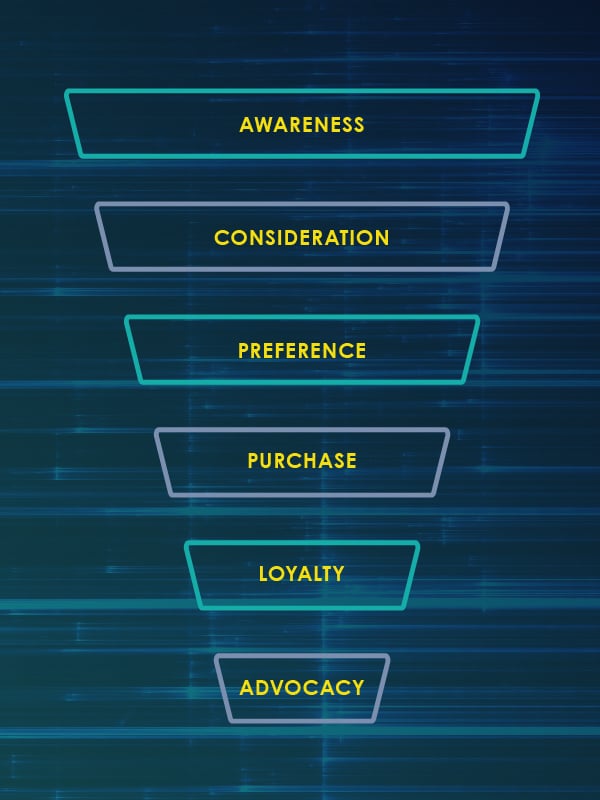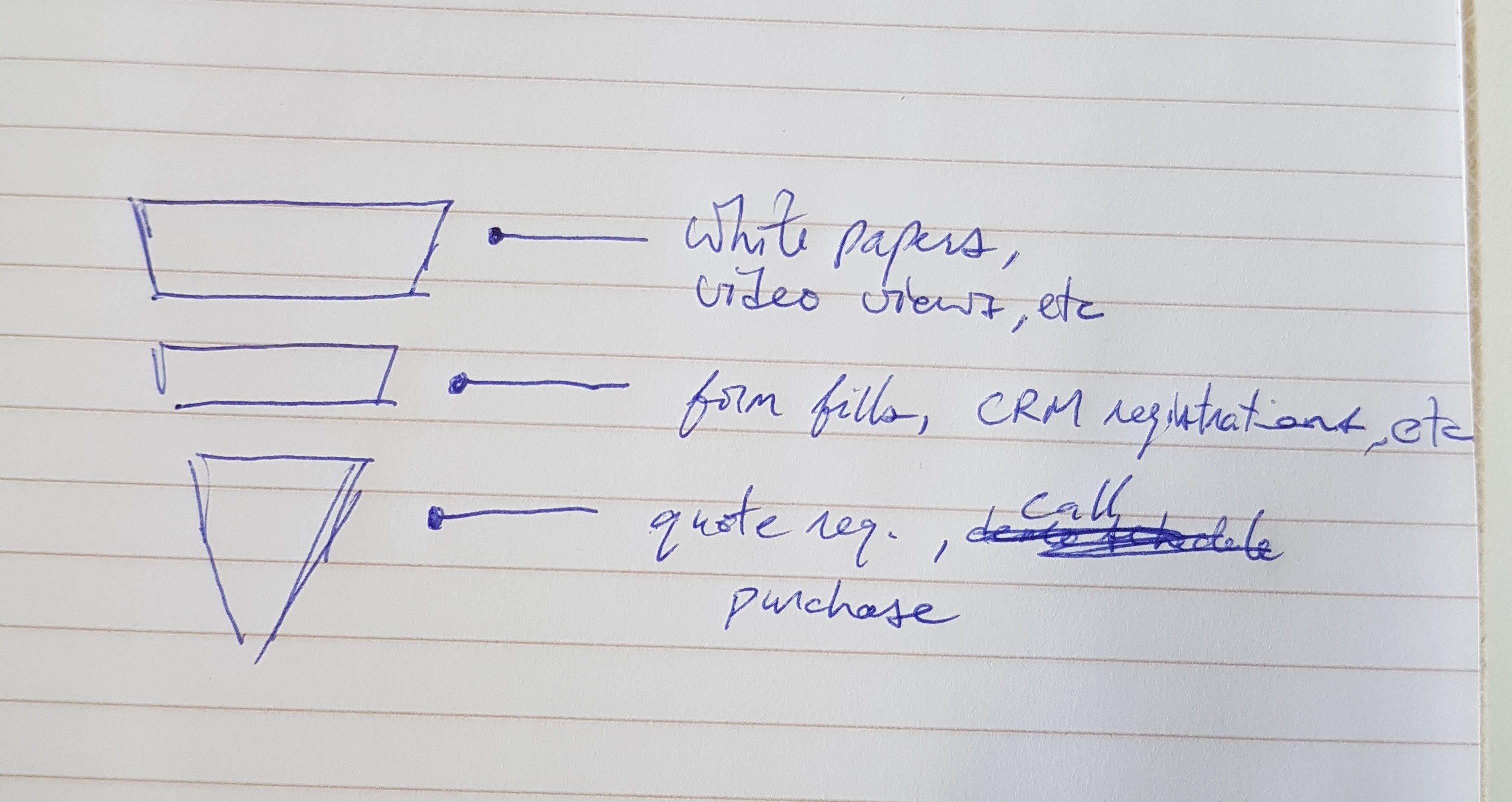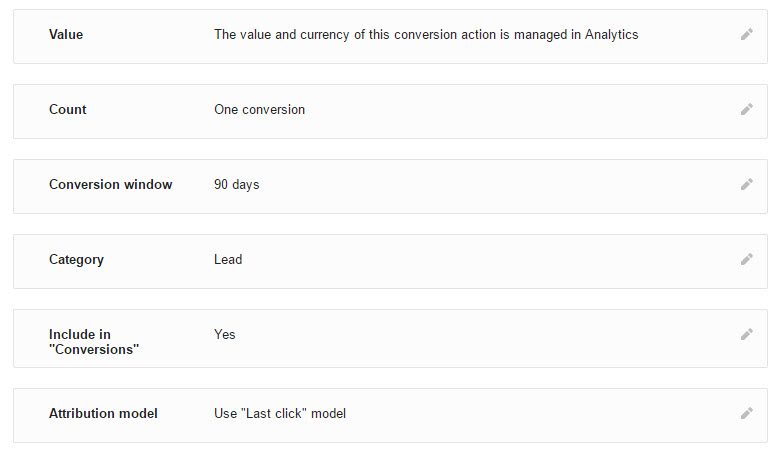
Why Fewer Conversions is Better
Wait a second, this is completely counter-intuitive to the conversion-based tactic of paid search. Why would you want to invest money in ads for fewer conversions? The truth is, not all conversions are created equal. A key assumption here is that we want to use paid search to get conversions that generate a return; meaning revenue directly generated by paid search. You may be asking yourself – aren’t all conversions meant to generate revenue?
The Marketing Funnel
The most successful marketing strategies are powered by a multi-stage funnel. Consumers can go through five or more different stages before they decide to buy, so developing content and corresponding campaign touch points for each stage is vital.

The Problem with Conversions
By developing a content funnel, we can use data from Google Analytics to get insight into what proportion of total traffic is likely to convert and become a customer. The higher up in the funnel, the “colder” they are and therefore the less likely they’ll be ready to make a purchase. Identifying audience segments is easy since each will interact differently with content. For example, someone who is in the awareness phase isn’t likely to spend much time on a pricing page. This isn’t because they aren’t interested in knowing how much the product will cost, it’s simply because they haven’t received enough information about the product itself to concern themselves with the price. In this case, we provide high-level information that informs them, like case studies, product pages or white papers. Aside from manual data analysis, Adwords conversions are a great way to capture these various funnel engagements in order to get a clear understanding of where any one user is within the buyer’s journey. Campaigns can then be modeled around these engagement points so the messaging and content are aligned with their specific point in the journey.

How to Set Up Conversion Tracking (the Right Way)
When setting up these conversions in Adwords, they are often set to the default setting: to be counted as a single conversion and aggregate into the “Conversion” column.  With that in mind, if downloading a whitepaper does not directly generate revenue but requesting a quote does and the platform considers them equal, the cost per conversion metric as a result is skewed. This means any optimizations you make will be based on an incorrect cost per conversion value. If campaign decisions are made based on an incorrect value, it is likely that you (or your client) will not be making the highest return.
With that in mind, if downloading a whitepaper does not directly generate revenue but requesting a quote does and the platform considers them equal, the cost per conversion metric as a result is skewed. This means any optimizations you make will be based on an incorrect cost per conversion value. If campaign decisions are made based on an incorrect value, it is likely that you (or your client) will not be making the highest return.
The (Temporary) Solution to Conversion Tracking
We know that tracking funnel engagements with conversions can help us improve our campaigns with advanced user segmentation. We also know that tracking “soft” conversions can inflate our cost per conversion metric. What can be done to fix this problem? By simply disassociating top-of-funnel conversions from the conversion column in Adwords, it is possible to see the true cost per conversion. 
The Results
Don’t worry, the data for top-of-funnel conversions is not lost! With this view, the “Conversions” metric only has bottom-of-funnel conversions, which contribute directly to revenue. While the “All conversions” metric counts both top and bottom of funnel conversions. 
Put It Into Action
You may be wondering – is it worth all of the extra steps? Absolutely. Think about it in terms of managing your own account or your client’s account. Using the real cost per conversion will allow you to:
- See how revenue-oriented campaigns are actually performing against the target CPA’s
- Monitor ongoing CPA trends to identify industry changes
- Easily decide where budget should be allocated/reallocated
Again, this doesn’t mean you should disregard the “other conversions”. This means you should review those metrics to:
- Decide whether it makes sense to continue allocating budget towards top-of-funnel content.
- Get a better idea of how top-of-funnel is contributing to bottom of funnel results.
Best Practices for Conversion Tracking
While this tactic has value, it is not the ideal solution. The best practice is to calculate the lifetime value of a customer at every stage of the funnel and assign these values to the conversions. This would make any optimization decisions based on a cost per conversion value, which is basically the ROI for each campaign, ad group, ad, or keyword. 
Conclusion
To understand how each conversion contributes to the bigger picture is the foundation of any successful digital strategy. Not all conversions will directly contribute to the bottom line, but that doesn’t mean they should be disregarded. To make this important distinction and segment conversions ensures they can be accurately analyzed and budget can be prioritized accordingly.
Need help setting up your conversion funnel in Adwords? Get in touch and we can help you track your campaign results more effectively.
